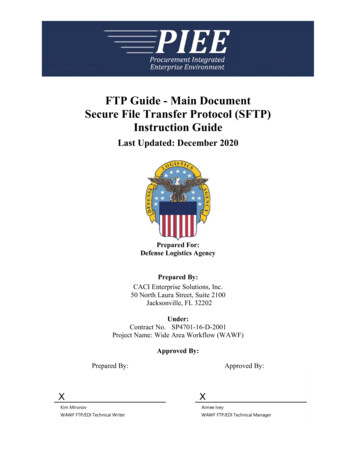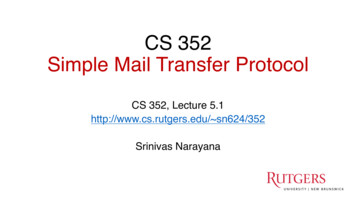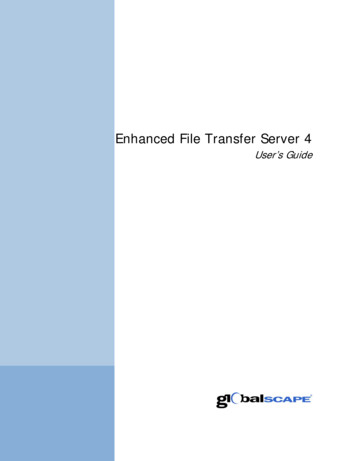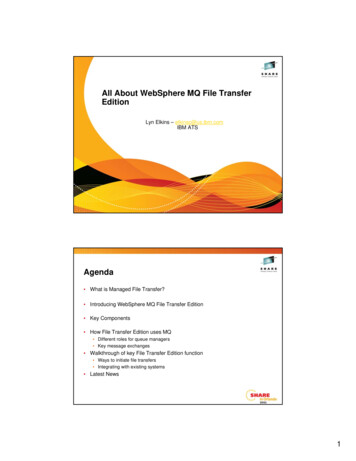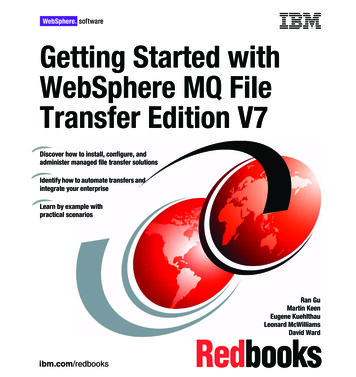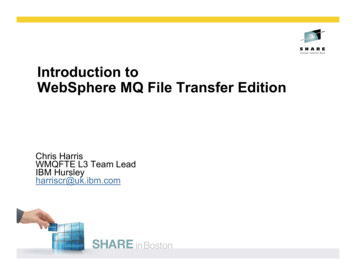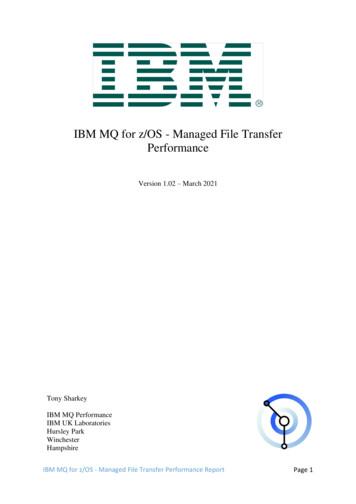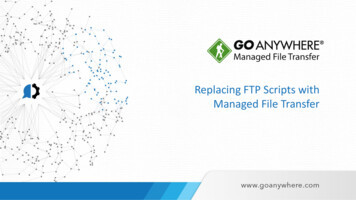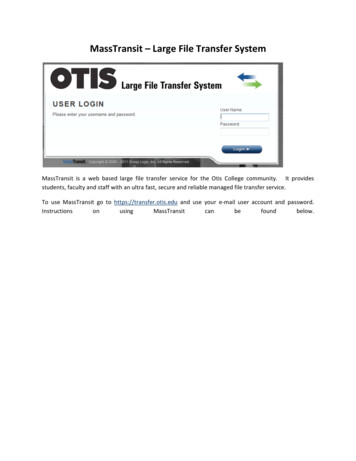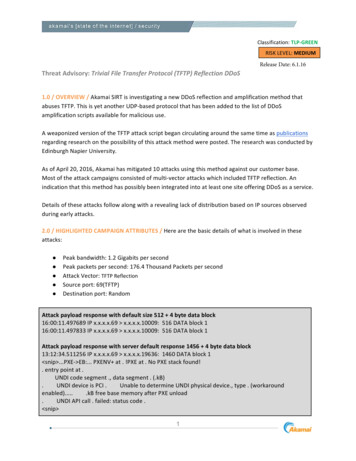
Transcription
Classification: TLP-GREENRISK LEVEL: MEDIUMRelease Date: 6.1.16Threat Advisory: Trivial File Transfer Protocol (TFTP) Reflection DDoS1.0 / OVERVIEW / Akamai SIRT is investigating a new DDoS reflection and amplification method thatabuses TFTP. This is yet another UDP-based protocol that has been added to the list of DDoSamplification scripts available for malicious use.A weaponized version of the TFTP attack script began circulating around the same time as publicationsregarding research on the possibility of this attack method were posted. The research was conducted byEdinburgh Napier University.As of April 20, 2016, Akamai has mitigated 10 attacks using this method against our customer base.Most of the attack campaigns consisted of multi-vector attacks which included TFTP reflection. Anindication that this method has possibly been integrated into at least one site offering DDoS as a service.Details of these attacks follow along with a revealing lack of distribution based on IP sources observedduring early attacks.2.0 / HIGHLIGHTED CAMPAIGN ATTRIBUTES / Here are the basic details of what is involved in theseattacks: Peak bandwidth: 1.2 Gigabits per secondPeak packets per second: 176.4 Thousand Packets per secondAttack Vector: TFTP ReflectionSource port: 69(TFTP)Destination port: RandomAttack payload response with default size 512 4 byte data block16:00:11.497689 IP x.x.x.x.69 x.x.x.x.10009: 516 DATA block 116:00:11.497833 IP x.x.x.x.69 x.x.x.x.10009: 516 DATA block 1Attack payload response with server default response 1456 4 byte data block13:12:34.511256 IP x.x.x.x.69 x.x.x.x.19636: 1460 DATA block 1 snip .PXE- EB:. PXENV at . !PXE at . No PXE stack found!. entry point at .UNDI code segment ., data segment . (.kB).UNDI device is PCI .Unable to determine UNDI physical device., type . (workaroundenabled).kB free base memory after PXE unload.UNDI API call . failed: status code . snip 1
Attack payload 308:53:03.540217 IP x.x.x.x.69 x.x.x.x.51716: 1460 DATA block 108:53:03.541582 IP x.x.x.x.214.69 x.x.x.x.46625: 1460 DATA block 1Attack payload 418:38:18.086417 IP x.x.x.x.69 x.x.x.x.41886: 516 DATA block 1 snip .L.!This program cannot be run in DOS mode. snip 18:38:18.090832 IP 209.242.10.150.69 185.34.104.45.62798: 516 ERROR ENOTFOUND "Can't openfile for read/write"Figure 1: Payload samples from all 4 attacks. Only the first block of DATA (block 1) is sent to the target.Figure 2: Respresents source ASN information of reflectors used in DDoS attacks against our customers.3.0/ ATTACK CHARACTERISTICS / Trivial File Transfer Protocol has been around for years. It can be usedfor file transfers of firmware and configuration files, typically for networking devices, but it's not limitedto just those devices.2
Its simple design leaves out many features like authentication and directory listing capabilities. Thissimplicity also makes it ideal for use in PXE (Preboot eXecution Environment) deployments which arenormally only LAN accessible and listen on UDP port 69 by default. Malicious actors have now added thisprotocol to the growing arsenal of reflection based amplification DDoS attack vectors using TFTP serversthat are exposing this port to the internet.Still, there are some limitations to the effectiveness of this attack using the currently observed methods.Based on observed attack payloads, the behavior seems consistent with what is expected and describedin RFC 1350. The targets of the TFTP reflection DDoS are flooded with RRQ(read request) DATAresponses. The attack tool, described later, makes a default request for a file, "/x" in this case from theTFTP server. The victim TFTP server returns data to the requesting target host as a result of this requestregardless of the filename mismatch.A similar request can be made using a tftp client from the command line on Linux. Running a commandsuch as "tftp localhost -c get /x" will result in the request payload below which would subsequentlytimeout unless tested against a real tftp server.Command: tftp localhost -c get /x15:21:43.291149 IP (tos 0x0, ttl 64, id 58345, offset 0, flags [none], protoUDP (17), length 42)x.x.x.x.49915 x.x.x.x.69: [udp sum ok] 14 RRQ "/x" netasciiE.*.@.E.p./x.netascii.Figure 3: Payload sample of basic tftp read request for file "/x" using regular TFTP client.Based on lab testing, most TFTP servers won't respond to this request. The result would normally be afile not found or other error message. As with other popular methods of reflection like NTP, SSDP, andDNS, the requests are sent at alarming rates and simultaneously to multiple TFTP servers.The request is forged in a way that forces the victim TFTP server to respond back to the malicious actorsintended target IP.Although the TFTP reflectors used thus far contain large files, sometimes over 20K bytes, only a limitedportion is returned. TFTP sends back data in specific block sizes, by default this is 512 bytes of data anadditional 4 bytes of options (516 total bytes). The largest replies observed in attacks have contained1,460 bytes all together as part of the payload.This puts amplification at 36.86 and 104.29 for those two payloads respectively without taking IP andUDP headers into consideration. Luckily TFTP only sends out data in specific block sizes and requiresacknowledgement of each block being received. Since the target of the attack will never acknowledgethe data, only the first block is sent. This mitigates the potential of higher amplification based on singlerequests.3
The next section will delve into a weaponized version of this attack tool already in the wild.4.0/ AMPLIFICATION DDOS TOOL / Not much time was wasted it seems by malicious actors in creating ascripted attack tool for TFTP DDoS. A total of 4 attacks have been observed so far starting in March 14th.The largest attack using only TFTP reflection peaked at 1.2 Gbps. The release of the attack script alsoseems to coincide with media publications regarding the research into the possibility of this attackmethod.The attack tool borrows much of the same code as other UDP based reflection tools. The command lineis similar as well. The input required is a target IP (used as the source of the attack tool requests), theport(usually seen as the destination port at the target),file listing TFTP server addresses, number ofthreads, packet per second rate limit, and attack run time.The attacks observed in most cases ignored the port parameter and resulted in random ports. Below is asample of the requests going out as seen in tcpdump within a lab environment.13:37:28.646587 IP x.x.x.x.44235 x.x.x.x.69:13:37:28.647979 IP x.x.x.x.44235 x.x.x.x.69:13:37:28.648357 IP x.x.x.x.44235 x.x.x.x.69:13:37:28.648617 IP x.x.x.x.44235 x.x.x.x.69:13:37:28.651597 IP x.x.x.x.44235 x.x.x.x.69:13:37:28.652093 IP x.x.x.x.44235 x.x.x.x.69:13:37:28.653410 IP x.x.x.x.44235 x.x.x.x.69:13:37:28.655413 IP x.x.x.x.44235 x.x.x.x.69:13:37:28.656291 IP x.x.x.x.44235 x.x.x.x.69:13:37:28.657912 IP x.x.x.x.44235 x.x.x.x.69:14 RRQ "/x" netascii14 RRQ "/x" netascii14 RRQ "/x" netascii14 RRQ "/x" netascii14 RRQ "/x" netascii14 RRQ "/x" netascii14 RRQ "/x" netascii14 RRQ "/x" netascii14 RRQ "/x" netascii14 RRQ "/x" netasciiFigure 4: Ten packet sample of the attack tool flood of requests.The payload in the attack request is the same as the command line version performed previously. Thecode contains a section defining the parameters used in the attack request payload as shown below.memcpy((void *)udph sizeof(struct x63\x69\x69\x00", 14);Figure 5: Attack script tool payload portion.4
The values translate to the following TFTP options:00 01 - opcode 1 read request(RRQ)2f 78 - /x filename specified00 filename terminating byte6e 65 74 61 73 63 69 69 - mode netascii using mode netascii00 mode terminating byteFigure 6: Represents the byte translation of TFTP options.The same values can be seen in wireshark when examining either a regular TFTP request done from thecommand line with mode "netascii" or using the attack tool.Figure 7: Wireshark view of tftp request payload.The specific reasoning behind using"/x" as a filename is unknown at this point. This is likely thefirst thing that worked to initiate a file transfer on some TFTP servers. Inspection of attackpayloads so far seems to indicate that the affected victims being leveraged for this reflection arepart of PXE deployments. Testing with regular standalone TFTP servers reveals that these are notsuitable reflectors. A common error from these servers is a simple file not found message.5.0 / RECOMMENDED MITIGATION / This method of attack will not generate a high packet rate but thevolume generated may be enough to consume bandwidth at the target site. So far the peak traffic for asingle vector TFTP only attack has been measured at just over 1 Gbps.TFTP is not recommended to be used over the internet. As such here are some precautions that maymitigate further use of this reflection method.For those hosting TFTP servers:- Assess the need to have UDP port 69 exposed to the internet.This should be firewalled and only allowed to trusted sources.- Snort or a similar IDS can be used to detect for the abuse ofTFTP servers in your network(rule provided below)Customized Snort Detection:5
alert udp EXTERNAL NET any - HOME NET 69 \(msg: "TFTP DDoS Abuse request"; \flow: to server; \content: " 00 01 2f 78 00 6e 65 74 61 73 63 69 69 00 "; dsize:14 14; \classtype:Reflection-Abuse; \sid: 201600003; rev:1;)For targets of TFTP amplification DDoS:- Upstream filtering of UDP source port 69 can be applied if possible- A DDoS mitigation provider can also be leveraged to absorb attack traffic generated5.0 / CONCLUSION / This attack will likely see more use as part of multi-vector attack campaigns. Theappearance of this vector in multi-vector campaigns is early evidence of possible inclusion into one ormore sites offering DDoS as a service.Alone, TFTP has produced a 1.2 Gbps attack but multi-vector campaigns, where TFTP is just one of manyvectors, have peaked at just over 44 Gbps. So far, sources of TFTP reflection attacks collected during theearly stages of attacks are poorly distributed. Mostly these are originating out of Asia with later attacksadding in sources from Europe.This attack is also limited by the nature of TFTP as it's designed to deliver files, typically configurationfiles, but to a limited number of hosts at a time. In fact, messages like "Out of memory" in attacksignatures allude to TFTP servers not being able to handle the rapid fire queries sent by the TFTP floodattack tool.As stated above, we recommend the following steps to mitigate the threat:For those hosting TFTP servers, assess the need to have UDP port 69 exposed to the Internet. Thisshould be firewalled and only allowed to trusted sources. Snort or a similar IDS can be used to detect forthe abuse of TFTP servers in your network.Customers who believe they are at risk and need additional direction can contact Akamai directlythrough CCare at 1- 877-4-AKATEC (US And Canada) or 617-444-4699 (International), their EngagementManager, or account team.Non-customers can submit inquiries through Akamai’s hotline at 1.877.425.2624, the contact form onour website at http://www.akamai.com/html/forms/sales form.html, the chat function on our websiteat http://www.akamai.com/ or on twitter @akamai.6
To access other white papers, threat bulletins and attack reports, please visit our Security Research andIntelligence section on Akamai Community.7
1 Threat Advisory: Trivial File Transfer Protocol (TFTP) Reflection DDoS 1.0 / OVERVIEW / Akamai SIRT is investigating a new DDoS reflection and amplification method that abuses TFTP. This is yet ano
